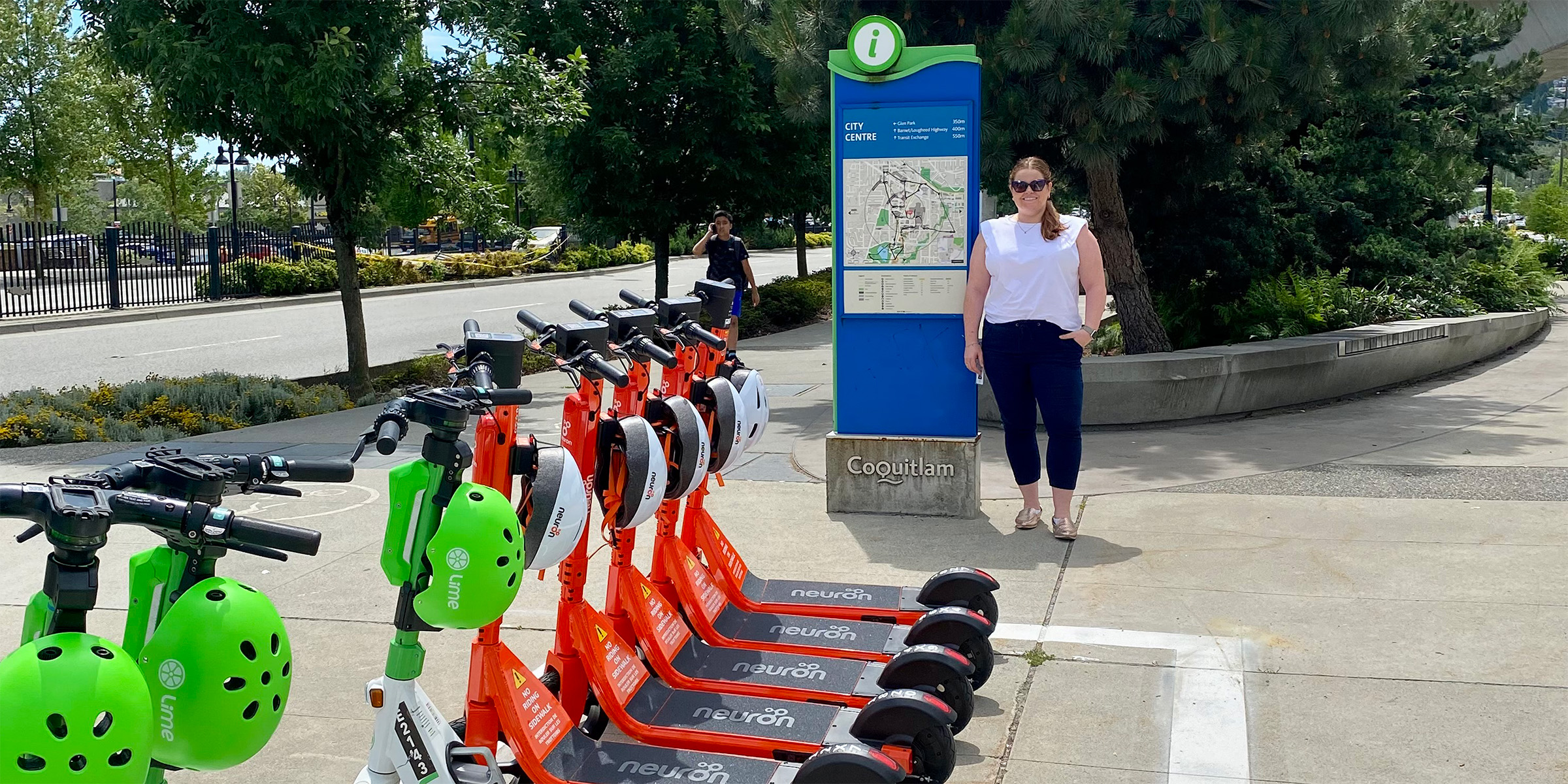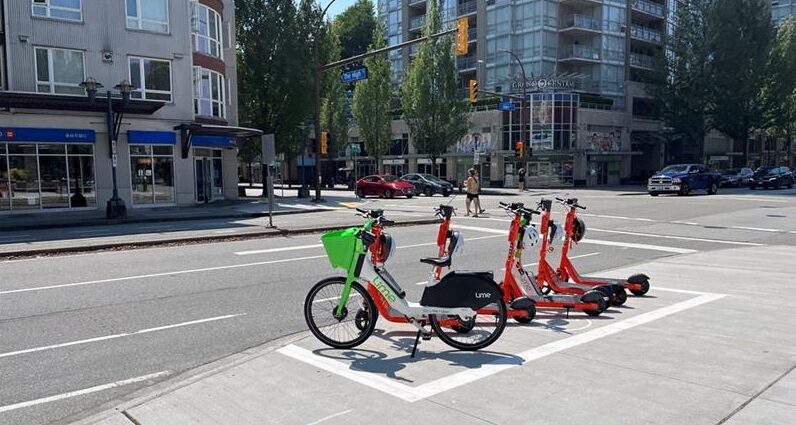
Electric scooters serving high density, transit-oriented areas in City of Coquitlam
Case Study
Published: May 28, 2025
Updated: n/a
Relevant Topics: Policy, Transportation
The City of Coquitlam launched a shared e-scooter and e-bike pilot in 2023 to support its climate goals and improve local transportation options. The City’s program has evolved since its launch in 2023, and staff expect to continue to adapt program elements based on rider data, resident feedback, and transit connectivity. Between June 2023 and December 2024 users have travelled over 180,000 kms on the program’s shared e-devices resulting in 6,200 kgs of carbon dioxide equivalents avoided. In this case study, City staff share key insights that might help others tailor a shared e-mobility program to the characteristics and travel patterns of their community.
Published: May 28, 2025
Updated: n/a
Relevant Topics: Policy, Transportation
Climate Zone: 4
Context
Coquitlam is a growing, urban city in the Lower Mainland of British Columbia, located about 30 kilometers east of downtown Vancouver. It is part of Metro Vancouver and is bordered by Burnaby, Port Moody, and New Westminster to the west, and Port Coquitlam and the Fraser River to the south. Its proximity to major transportation routes, including Highway 1 and Lougheed Highway, connects Coquitlam easily to other parts of Metro Vancouver and communities in the Fraser Valley. Coquitlam has a mix of high-density urban areas, suburban neighbourhoods, and natural green spaces, with significant residential and commercial development concentrated around key transit hubs, such as Coquitlam Central Station on the SkyTrain's Evergreen Extension. The city has a rapidly growing population, diverse community, and expanding infrastructure, making it an important hub for housing, employment, and transportation in the region. The City’s corporate and community greenhouse gas emissions reduction targets are: 45 per cent by 2030 (below 2007 levels) and to achieve carbon neutrality by 2050.

Contributors

Angela Jarvis
Electric Mobility Manager
City of Coquitlam

Jen Grebeldinger
Director, Communications & Engagement
Community Energy Association

Danielle Wiess
Director of Transportation Initiatives
Community Energy Association
Problem
The city is currently developing an E-Mobility Strategy as part of the Strategic Transportation Plan update. Included in this, and as part of ongoing efforts to reduce greenhouse gas (GHG) emissions from transportation, City staff are also focused on enhancing transportation options and connecting transit riders to the first and last kilometer of their commute. The Provincial Electric Kick Scooter Pilot presented City staff with an opportunity to both advance strategic operational plans and evaluate how shared micromobility would work in the community. With its traditional suburban land use design and road network alongside the increase in high density housing around rapid transit hubs, new pressures have emerged for convenient active transportation options.
Solution
In early 2023, the City of Coquitlam joined the Provincial electric kick-scooter pilot and City staff were instructed by Council to plan and implement a Shared E-Micromobility Pilot for e-scooters and e-bikes. Six months later in June 2023, following a Request for Proposals process, the program launched with 200 devices from 2 operators using a hybrid dockless parking model. The number of devices deployed increased in July 2024 to 450 comprising of 86% e-scooters and 14% e-bikes. In the town centre area, signed mandatory dockless parking stations are the only permitted spots to park devices whereas in the surrounding service area, flexible parking was permitted. While the program launched with both Lime and Neuron as operators, Neuron withdrew its fleet at the end of 2024 and so the program now operates with a single vendor, Lime. Angela Jarvis, E-Mobility Manager at the City of Coquitlam, noted “…it can be a challenge for [two vendors] to garner sufficient market share and hence revenue to be viable.”
Cost
According to the Transportation Association of Canada (TAC) report, “Shared Micromobility Services in Canadian Communities”, Coquitlam’s program is a ‘managed’ delivery model. As the fleet operator, Lime has a contractual agreement with the municipality and pays a fee to deliver services and access the City right-of-way. In addition to municipal staff dedicating capacity to oversee the program and manage the relationship and contract with the operator, in the first year of the program Coquitlam also provided capital to cover infrastructure expenses associated with dockless parking stations and signage. “Our 6-month procurement cycle was tight, so we took the lead on parking infrastructure so the operators could focus on deploying the fleet. This is one way to expedite implementation, but it does create an expense,” Jarvis says. Starting in 2024, the provision of new dockless parking stations became a responsibility of the operator, thereby reducing the cost to the municipality. In 2023, the net cost of the program to the City was $129,600 and in 2024 the cost was $36,500. These costs are funded by the City’s E-Mobility Program.
Mandatory Dockless Stations
Locations are identified in the app and by signs and/or pavement markings and users must park vehicles within the identified area.

Lime e-scooters parked in a mandatory dockless station outside Coquitlam Central Station.
Dockless Parking
Devices have on-board locking mechanisms allowing users to find vehicles through an app and park them anywhere in the service area; this allows users to ride directly to their destination. The operators and the City rely on education to encourage users to follow certain rules like not parking the devices on sidewalks or roads.
Education and Outreach
E-Mobility Manager, Angela Jarvis, was aware at the outset that once the City was part of the Provincial kick e-scooter pilot, they had to do broad education and outreach to the community based on the associated temporary changes to the motor vehicle act. “Whether someone was going to be operating a private e-scooter or one of the shared devices, we had to make sure residents were aware of safety measures, rules, and etiquette,” explains Jarvis. “We started fulsome communications early and made in-person test ride and education events part of our contract with operators.” Together, the City and operators delivered 14 in-person safety and education events to residents. Jarvis was also aware that the program required collaboration from other City departments. “There was internal concern about pedestrian safety, rightly so, on multi-use paths especially through parks. We were able to talk to our colleagues about the tools and rules we had in place to enhance safety, like geofencing technology that automatically lowers the allowable speed on a device in certain areas.”
Resident Concerns
Like other programs, resident complaints and service requests peaked in the early months of the program, but leveled out over time as adjustments were made and both users and the public became more aware of proper operations. Jarvis does highlight the learnings about what the community believes is acceptable in terms of aesthetics and accessibility, and the need to make appropriate accommodations and adjustments when needed. To that end, she and the project team collaborated with their communications department to gather data beyond the official city channels. This “communications sentiment analysis” monitored unofficial city channels to get a sense of the actual vibe of community beyond service requests and surveys. “This was helpful data to have to illustrate in our reports [to council] that we had a pulse on the broader community and heard the sentiments of residents who are not directly engaged with the program.” Having this sentiment data often contextualized service requests and complaints within the broader conversation of transportation behaviour and the unavoidable process of normalizing micromobility withing the community’s landscape. “Do what you can to adapt the program based on what your community is saying,” advises Jarvis, “but remember to contextualize non-compliance behaviour alongside others that are commonly accommodated or normalized.”
Outcome
Between June 2023 and December 2024 over 106,000 trips were made by over 15,000 different users. With an average trip distance of 1.8 kms, that’s over 180,000 km travelled on the program’s shared e-devices resulting in 6,200 kgs of carbon dioxide equivalents avoided. This is roughly equivalent to 2% of their annual emissions from private transportation. Considering the small service area, just 8km², this highlights how shared micromobility programs can be tailored to the characteristics and travel patterns of a community to achieve success. “Coquitlam is very much on track for having the same annual number of trips as Richmond and the North Shore with a significantly smaller service area,” says Jarvis, adding, “we have three sky train stations in our service area, and population density surrounding those stations, so the demand is really high for this transportation option.”

Heat maps of travel patterns, provided by the operators, show clearly that use is heaviest surrounding these high-density, transit-oriented areas. In fact, thirty percent of trips are starting or ending within 100 m of a transit station, and use rates are lower at stations where the e-scooter parking isn’t as convenient. “This really shows how connectivity between different modes of transportation can influence travel patterns”. The data gleaned from heat maps also made it possible for the project team to make adjustments based on user demand. In the case of the transit stop that had lower use rates, the City worked with TransLink to enable access for shared micromobility devices on TransLink-owned property.
User data showed that usage of e-scooters peaked between 9 p.m. and 2 a.m. This timeframe aligns with the decrease in public transit frequency indicating that users are likely augmenting their transit use. Jarvis notes, “When someone is looking at a 25 to 45 minute wait time for public transit, it’s a lot more convenient to pick up a shared e-scooter or e-bike instead.” On this data point Jarvis adds that in addition to replacing car trips, “mode substitution matters, even in the suburbs. It’s important that the transportation system as a whole is working for people.”
Contributors

Angela Jarvis
Electric Mobility Manager
City of Coquitlam

Jen Grebeldinger
Director, Communications & Engagement
Community Energy Association

Danielle Wiess
Director of Transportation Initiatives
Community Energy Association
Move from inspiration to implementation
With a great case study, you can learn what has worked in a community like yours. You can be inspired to bring an innovation home.
But you don't have to struggle to implement this on your own. Join the BC Local Government Peer Networks to gain the support you need to take inspiration to implementation.
Related Content
How the City of Kelowna welcomed electric kick scooters to its streets
With a target of 1 in 4 trips made by sustainable modes, in 2021 the City of Kelowna joined the provincial pilot program for electric kick scooters. By 2024, Kelowna claimed the highest per capita ridership in Canada for shared micromobility.




